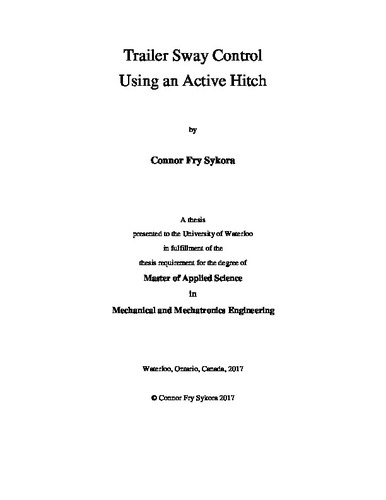| dc.contributor.author | Fry Sykora, Connor | |
| dc.date.accessioned | 2017-08-24 20:34:16 (GMT) | |
| dc.date.available | 2018-08-25 04:50:06 (GMT) | |
| dc.date.issued | 2017-08-24 | |
| dc.date.submitted | 2017-08-21 | |
| dc.identifier.uri | http://hdl.handle.net/10012/12208 | |
| dc.description.abstract | The handling and yaw stability characteristics of passenger vehicles are drastically changed when towing a trailer, which can lead to unsafe oscillations in the trailer yaw, known as trailer sway. This thesis examines the feasibility of using lateral articulation of the hitch ball to reduce sway behavior in passenger-sized tractor-trailer configurations. An articulating hitch ball design has the advantage of not being dependent on the trailer being towed, providing stability improvements to the wide variety of trailers that a passenger vehicle may tow over its life cycle.
Changes in the lateral position of the hitch relative to the tractor create dynamic changes to the heading angle of the trailer relative to the tractor, which act as compensating steering inputs into the system. To examine the effectiveness of this method, a linear handling model was developed to predict the system response with different trailer configurations and feedback methods. This model was simulated with various feedback controllers, and the modeling was validated using a model constructed in MapleSim, a high-fidelity multibody simulation tool.
After establishing the required performance characteristics of the active hitch, a prototype was designed, manufactured, and tested in a full scale tractor-trailer combination. The modeling techniques showed good agreement with the physical testing, where the control design of proportional feedback on the trailer articulation angle provided improved yaw stability across many trailer configurations. The simple controller design is adaptable to driving conditions and requires minimal measurements of vehicle states. The performance of the active hitch prototype is best shown in a response to a steering impulse at 65km/h, where a highly unstable trailer causes steady state oscillation without control, and settles in under 4 seconds with control active. | en |
| dc.language.iso | en | en |
| dc.publisher | University of Waterloo | en |
| dc.subject | Vehicle Dynamics | en |
| dc.subject | Trailering | en |
| dc.subject | Active Safety | en |
| dc.title | Trailer Sway Control Using an Active Hitch | en |
| dc.type | Master Thesis | en |
| dc.pending | false | |
| uws-etd.degree.department | Mechanical and Mechatronics Engineering | en |
| uws-etd.degree.discipline | Mechanical Engineering | en |
| uws-etd.degree.grantor | University of Waterloo | en |
| uws-etd.degree | Master of Applied Science | en |
| uws-etd.embargo.terms | 1 year | en |
| uws.contributor.advisor | Khajepour, Amir | |
| uws.contributor.affiliation1 | Faculty of Engineering | en |
| uws.published.city | Waterloo | en |
| uws.published.country | Canada | en |
| uws.published.province | Ontario | en |
| uws.typeOfResource | Text | en |
| uws.peerReviewStatus | Unreviewed | en |
| uws.scholarLevel | Graduate | en |

